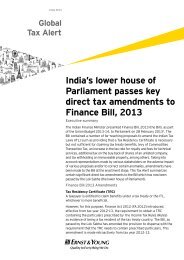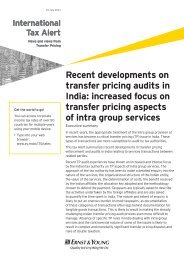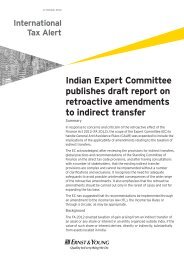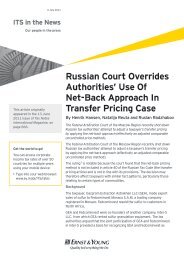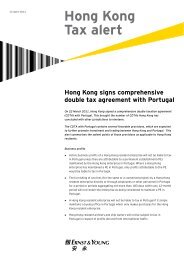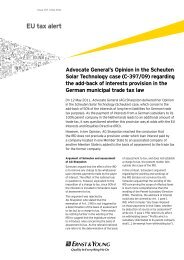(GST) compliance obligations (pdf, 5.62 MB) - Ernst & Young T ...
(GST) compliance obligations (pdf, 5.62 MB) - Ernst & Young T ...
(GST) compliance obligations (pdf, 5.62 MB) - Ernst & Young T ...
Create successful ePaper yourself
Turn your PDF publications into a flip-book with our unique Google optimized e-Paper software.
“There has been considerable<br />
overall progress in the use of<br />
e-filing for the major taxes<br />
and a number of bodies can<br />
report substantial progress<br />
over the last five years.<br />
For many, this progress<br />
has been facilitated by the<br />
use of mandated e-filing<br />
requirements (e.g., CIT, VAT<br />
and employers’ wage income<br />
reports). However, around<br />
30% of surveyed revenue<br />
bodies still have considerable<br />
progress to make across<br />
some or all of the major<br />
taxes, including a number<br />
who have made quite limited<br />
progress over the last five<br />
years.”<br />
The Organisation for<br />
Economic Cooperation and<br />
Development<br />
Survey of Trends and<br />
Developments in the Use<br />
of Electronic Services for<br />
Taxpayer Service Delivery<br />
March 2010<br />
VAT returns and payments<br />
Companies that are registered for VAT in a number of jurisdictions or MNE groups that<br />
use shared services centers must also contend with different VAT reporting dates and<br />
the widely different formats used for VAT returns.<br />
For large companies, VAT return periods vary from monthly (most common) to<br />
bi-monthly, quarterly and bi-annual. In addition to periodic filings, 19 countries also<br />
require annual returns and 2 countries require interim payments on account. EU<br />
countries also require statistical information (INTRASTAT) returns and sales lists for<br />
taxpayers engaged in cross-border trade within the EU.<br />
VAT return submission dates range from 10 days to 2 months after the end of the<br />
return period. Payment of any return liability is generally required at the same time.<br />
Although the majority of countries provide for electronic submission of returns and<br />
payments, over a third still use paper forms (31) and nearly a third require payment by<br />
cheque (28). All but four countries require the VAT return to be signed in some way.<br />
These requirements can add greatly to the practical difficulties for companies that<br />
prepare and submit their returns from outside the country.<br />
No. of countries<br />
Figure 6: VAT return format and method of payment<br />
Source: <strong>Ernst</strong> & <strong>Young</strong><br />
No. of countries<br />
80<br />
70<br />
60<br />
50<br />
40<br />
30<br />
20<br />
10<br />
0<br />
80<br />
70<br />
60<br />
50<br />
40<br />
30<br />
20<br />
10<br />
0<br />
Figure 7: VAT return frequency<br />
Source: <strong>Ernst</strong> & <strong>Young</strong><br />
Electronic<br />
submission/<br />
bank transfer<br />
Monthly<br />
returns<br />
Electronic<br />
submission/<br />
cheque<br />
Bi-monthly<br />
returns<br />
21 VAT and <strong>GST</strong>: multiple burdens for multinational companies<br />
Form/<br />
bank<br />
transfer<br />
Methods of payment<br />
Quarterly<br />
returns<br />
Return frequency<br />
Form/<br />
cheque<br />
Bi-annual<br />
returns








